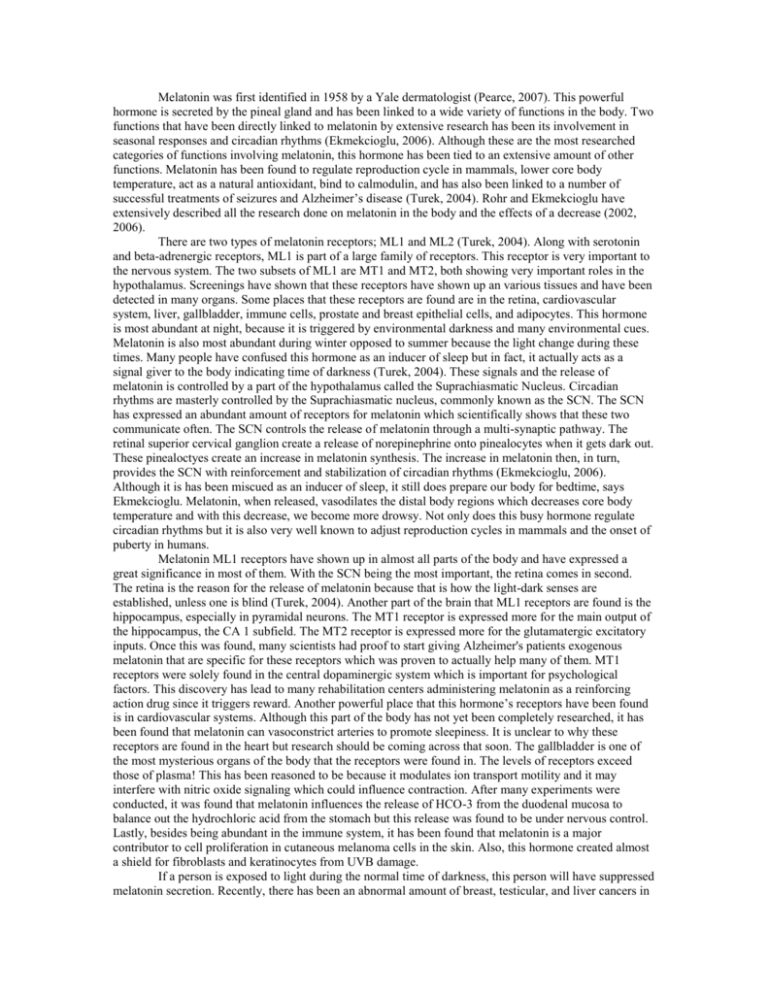File
advertisement

Melatonin was first identified in 1958 by a Yale dermatologist (Pearce, 2007). This powerful hormone is secreted by the pineal gland and has been linked to a wide variety of functions in the body. Two functions that have been directly linked to melatonin by extensive research has been its involvement in seasonal responses and circadian rhythms (Ekmekcioglu, 2006). Although these are the most researched categories of functions involving melatonin, this hormone has been tied to an extensive amount of other functions. Melatonin has been found to regulate reproduction cycle in mammals, lower core body temperature, act as a natural antioxidant, bind to calmodulin, and has also been linked to a number of successful treatments of seizures and Alzheimer’s disease (Turek, 2004). Rohr and Ekmekcioglu have extensively described all the research done on melatonin in the body and the effects of a decrease (2002, 2006). There are two types of melatonin receptors; ML1 and ML2 (Turek, 2004). Along with serotonin and beta-adrenergic receptors, ML1 is part of a large family of receptors. This receptor is very important to the nervous system. The two subsets of ML1 are MT1 and MT2, both showing very important roles in the hypothalamus. Screenings have shown that these receptors have shown up an various tissues and have been detected in many organs. Some places that these receptors are found are in the retina, cardiovascular system, liver, gallbladder, immune cells, prostate and breast epithelial cells, and adipocytes. This hormone is most abundant at night, because it is triggered by environmental darkness and many environmental cues. Melatonin is also most abundant during winter opposed to summer because the light change during these times. Many people have confused this hormone as an inducer of sleep but in fact, it actually acts as a signal giver to the body indicating time of darkness (Turek, 2004). These signals and the release of melatonin is controlled by a part of the hypothalamus called the Suprachiasmatic Nucleus. Circadian rhythms are masterly controlled by the Suprachiasmatic nucleus, commonly known as the SCN. The SCN has expressed an abundant amount of receptors for melatonin which scientifically shows that these two communicate often. The SCN controls the release of melatonin through a multi-synaptic pathway. The retinal superior cervical ganglion create a release of norepinephrine onto pinealocytes when it gets dark out. These pinealoctyes create an increase in melatonin synthesis. The increase in melatonin then, in turn, provides the SCN with reinforcement and stabilization of circadian rhythms (Ekmekcioglu, 2006). Although it is has been miscued as an inducer of sleep, it still does prepare our body for bedtime, says Ekmekcioglu. Melatonin, when released, vasodilates the distal body regions which decreases core body temperature and with this decrease, we become more drowsy. Not only does this busy hormone regulate circadian rhythms but it is also very well known to adjust reproduction cycles in mammals and the onset of puberty in humans. Melatonin ML1 receptors have shown up in almost all parts of the body and have expressed a great significance in most of them. With the SCN being the most important, the retina comes in second. The retina is the reason for the release of melatonin because that is how the light-dark senses are established, unless one is blind (Turek, 2004). Another part of the brain that ML1 receptors are found is the hippocampus, especially in pyramidal neurons. The MT1 receptor is expressed more for the main output of the hippocampus, the CA 1 subfield. The MT2 receptor is expressed more for the glutamatergic excitatory inputs. Once this was found, many scientists had proof to start giving Alzheimer's patients exogenous melatonin that are specific for these receptors which was proven to actually help many of them. MT1 receptors were solely found in the central dopaminergic system which is important for psychological factors. This discovery has lead to many rehabilitation centers administering melatonin as a reinforcing action drug since it triggers reward. Another powerful place that this hormone’s receptors have been found is in cardiovascular systems. Although this part of the body has not yet been completely researched, it has been found that melatonin can vasoconstrict arteries to promote sleepiness. It is unclear to why these receptors are found in the heart but research should be coming across that soon. The gallbladder is one of the most mysterious organs of the body that the receptors were found in. The levels of receptors exceed those of plasma! This has been reasoned to be because it modulates ion transport motility and it may interfere with nitric oxide signaling which could influence contraction. After many experiments were conducted, it was found that melatonin influences the release of HCO-3 from the duodenal mucosa to balance out the hydrochloric acid from the stomach but this release was found to be under nervous control. Lastly, besides being abundant in the immune system, it has been found that melatonin is a major contributor to cell proliferation in cutaneous melanoma cells in the skin. Also, this hormone created almost a shield for fibroblasts and keratinocytes from UVB damage. If a person is exposed to light during the normal time of darkness, this person will have suppressed melatonin secretion. Recently, there has been an abnormal amount of breast, testicular, and liver cancers in industrialized countries. There has been research done on this link to melatonin. One hypothesis is that because of the high exposure to light at night time, melatonin is unable to be produced which then does not allow it to be circulated around the body as a powerful antioxidant to the places that have the melatonin receptors. Melatonin levels are found to be important in breast tissue not only because of it’s antioxidant effects but also because it inhibits proliferation in estrogen-receptor alpha and it also facilitates the binding of estrogen by inhibitory effects on calmodulin. Melatonin, about two hours before bedtime, will increase, peaking in the middle of the night, and then falls gradually after the peak (Rohr, 2002). In blind individuals, it has been shown that melatonin is actually in a “free flowing” cycle (Ekmekcioglu, 2006). Many causes have been linked to a delay in melatonin production. A lot of this delay has to do with our busy lifestyles. Jetlag, sleeping disorders, and night work shifts are all culprits to why melatonin is not where it should be in a great portion of our society. It has also been linked that financial, marital, and social problems may cause melatonin phase delay (Rohr, 2002) Delayed sleep phase syndrome (DSPS) is a very well known sleep disorder where sleep is not able to come until usually about four a.m. In this sleeping disorder, melatonin rhythm is delayed by pushing it back at least seven hours. The peak is at about six a.m. and the high levels persist during early morning. The opposite of DSPS is ASPS also known as Advance sleep phase syndrome. This is when a person falls asleep around eight a.m. and will not wake up until three a.m. the next day. These melatonin levels have not been experimentally tested to draw scientific conclusions on. When a person is associated with desynchronized circadian rhythms, they are more likely to weight gain, oversleeping, and have carbohydrate cravings (Ekmekcioglu, 2006). Melatonin has been experimentally linked to reproduction cycles and was thought to bring upon Seasonal affective disorder (SAD). Although humans are non-seasonal breeders, it has been found that birth rates are correlated to environmental light which is linked to the production of melatonin, says Rohr (2002). This might seem like a far reach, saying that melatonin has an impact on our reproduction cycle just because of the light but it is shown in many other species of animals that melatonin mediates the reproduction cycle. This is also believed to pass to humans also. High melatonin has been shown to decrease reproduction in humans which is why there are more conceptions reported for the summer since melatonin levels are decreased. The hypothalmaic GnRH pulse generator, which is a part of the body that decreases sexual hormones, is inactivated during the change of season from summer to winter because melatonin levels change. Along with our reproduction clock, many researchers believed that melatonin had an effect on SAD but this has found to be untrue, says Rohr (2002). Many thought that because melatonin was sensitive to light that the increase of it during winter caused a depression. This was proven wrong when it was found that serotonin levels actually decreased during the winter. When a person was exposed to light to help their depression, their melatonin rhythms stayed the same as before the light was introduced. It was also found that people with darker eye color might be more susceptible to SAD because less light intensity is allowed to pass through their eyes. Because of how new this hormone is, there is a very well known and established hypothesis called “The Melatonin Hypothesis“ (Rohr, 2002). This hypothesis states “excess exposure to environmental light contributes to breast cancer risk via impaired pineal secretion of melatonin” (Ekmekcioglu, pg 8). This hypothesis also goes into state that blind people should exhibit lower levels of breast cancer since their melatonin levels are higher than people who are not blind. The melatonin hypothesis also gives many reasons to why a dietary supplement of melatonin should not be given as an over the counter drug yet. If used incorrectly, it can be a hypnotic and can promote sedation in humans when administered during the day when melatonin levels are expected to be low (Turek, 2004). Instead, a melatonin receptor agonist would be more effective than exogenous melatonin since it does not show as drastic affects. Melatonin is an abundant hormone that has to continue to be researched and understood. It has been found in many parts of our body and where one does understand it, one does see how important it is for our body to have. This is a type of hormone that is sensitive to light and can be easily lost if one does not take care of oneself. Abnormal production of melatonin has been linked to sleeping difficulties. It plays a significant role in regulating circadian rhythms and seasonal responses but has been found to maintain our body functions in other ways than simply that. Unlike many other hormones, melatonin is not suggested to be taken as a dietary supplement because of its sometimes unwanted effects (Ekmekcioglu, 2006)







